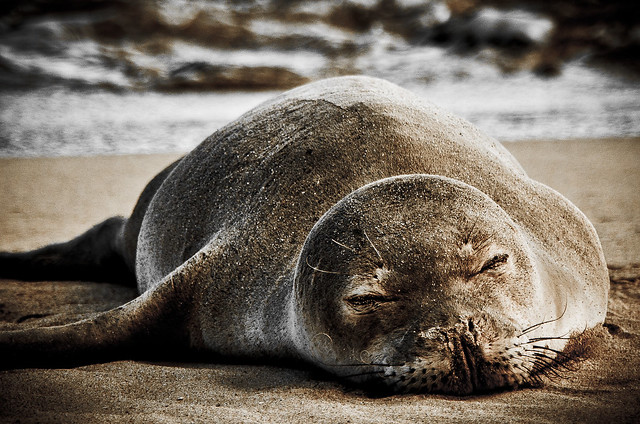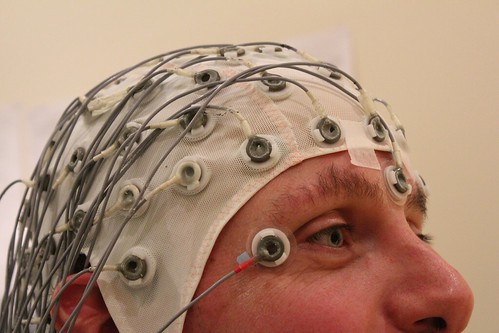Emma Dauster EARTH'S ORGANISMS
sleep unihemispheric adaptation brain
Sleeping One Hemisphere at a Time
When you go to sleep, your brain goes to sleep too, right? Well, that might depend on what kind of organism you are. For example, dolphins breathe air but live under water. So how do they sleep? Wouldn’t they suffocate under water? Well they continue to survive, so they must have an adaptation that allows them to get to the water’s surface for oxygen and achieve the restorative sleep that they need at the same time. That adaptation is called unihemsipheric sleep, in which several kinds of animals, including dolphins, can function with one half of their brain (hemisphere) asleep while the other half stays awake. This allows for enough function in the awake hemisphere to regulate breathing, body temperature, and their position in relation to predators.
Unlike fish, dolphins do not have gills and cannot get their oxygen out of the water. Rather, they periodically come to the water’s surface and inhale oxygen through a blowhole, which then closes tight to keep water out. If you’ve ever choked on food after laughing or gasping, you might be envious of dolphins who keep their breathing completely separate from eating through use of the blowhole [2]. But dolphins can’t swim to the water’s surface to inhale when they run out of oxygen in their sleep, so their adaptation of unihemispheric sleep allows them to retain one hemisphere awake at all times for that purpose.
Fig 1 - Dolphins use a blowhole on top of their heads to breathe air, then seal it tight to swim under water. Source: NASA, Wikimedia commons.
Contrary to unihemispheric sleepers like dolphins and birds, humans evolved to sleep at night because our eye sight is poor in the dark compared to under the light of the sun. That meant that early humans benefited from remaining motionless and silent, tucked away in a safe spot during those hours in which their predators might have the advantage of better vision. We are bihemispheric sleepers and go through long periods of time at night without movement, instead of remaining vigilant like unihemispheric sleepers during our most vulnerable hours. But is that the entire story?
Sleep researchers have found differences in neural activity between the hemispheres even in bihemispheric sleepers like humans. They have also determined that certain areas of our brains display higher sleep patterns WHILE AWAKE under specific environmental conditions and movements, which they call local sleep [1]. This implies that some parts of your brain may be sleeping while you are awake, as triggered by a certain way you move or environment you put yourself in. So there might be a little bit of unihemispheric sleep in all of us.

Fig 2 - Human baby sleeping bihemispherically with both eyes closed. Source: Creative Commons CC0 pxhere.
In marine mammals, both hemispheres are capable of sleeping but only one hemisphere sleeps at any given time. They switch off which hemisphere is currently asleep while the other one takes over wakefulness. This unihemispheric sleep allows for memory consolidation and restorative rest in both hemispheres. In the short period of change over, when one hemisphere is waking up and the other is falling asleep, there can be bihemispheric sleep, but this never lasts for more than a few seconds. Dolphins are not the only animals that utilize this cool sleeping method. Birds who sleep using the unihemispheric method mainly do so for the benefit of avoiding other animals that want to eat them [1].
Some birds and seals are more of a mixture between dolphins (unihemispheric) and humans (bihemispheric) when it comes to sleep. They may encounter a transitory unihemispheric sleep state on the way to bihemispheric sleep, in which one hemisphere falls asleep before the other one. You can tell this is happening because the bird will have one eye closed and one still open. For this reason, the unhemispheric sleep experienced by birds is called monocular. Dolphins also exhibit unihemispheric-monocular sleep, but it is less well characterized. Interestingly, when dolphins swim with one eye open in monocular sleep, they usually swim in groups of other dolphins and maintain the open eye toward the group so that they can stay with their friends. When they change position within the group, the eye that is open will also change to be the one looking at the group.

Fig 3 - This seal is bihemispherically sleeping with both eyes closed on land. Source: Jared Wong, flickr
Seals are cool to study in this case because they can sleep one hemisphere at a time or both at the same time depending on their environment. When they sleep on land, seals are more likely to sleep bihemispherically, but when they sleep in water they are more likely to sleep unihemispherically. This may be an advantage for survival against predators in the water, however seals can and do sleep unihemispherically on land and bihemispherically in water as well. They just don’t get as much deep sleep when they bihemispherically sleep in the water because they need to wake up for thermoregulation and to go to the surface to breathe. Before they hit deep sleep, seals can keep their nostrils above water by keeping one of their hemispheres awake to control the flipper on the other side of their body. Once they fall into rapid eye movement (REM) sleep, however, they sink below the surface.
One way we measure neural patterns during sleep and wakefulness is using electroencephalograms (EEGs). This technique is often used in human studies, requiring a lengthy application process to put the cap on. The human sleep studies I talked about earlier were conducted using this method. Researchers connect many small metal disks to someone’s scalp to read the electrical activity of large groups of neurons in their brains [3]. By looking at where activity is localized and how much activity there is, scientists can determine qualities of our sleep patterns such as local sleep. As it turns out, we bihemispheric sleepers might not be so different from unihemispheric sleepers after all.

Fig 4 - This man has many small metal disks hooked up to his scalp in an EEG setup to measure the electrical activity in his brain. Source: Tim Sheerman-Chase, flickr
References:
Mascetti, G. G. (2016). Unihemispheric sleep and asymmetrical sleep: behavioral, neurophysiological, and functional perspectives. Nature and Science of Sleep, 8, 221–238. http://doi.org/10.2147/NSS.S71970
WDC. 2018. “How Do Dolphins Breathe?” Accessed October 19, 2018. https://us.whales.org/faqs/facts-about-whales-and-dolphins/how-do-dolphins-breathe
Mayo Clinic Staff. 2018. “EEG (electroencephalogram)” Accessed October 19, 2018. https://www.mayoclinic.org/tests-procedures/eeg/about/pac-20393875
More From Thats Life [Science]
- Freshwater Mussels are Declining: Why Should You Care, and What Can You Do?
- The Story of Chestnuts in North America: How a Forest Giant Disappeared from American Forests and Culture
- Friendships, Betrayals, and Reputations in the Animal Kingdom
- Why Don't Apes Have Tails?
- Giant Bacteria, Giant Genomes
- More ›

